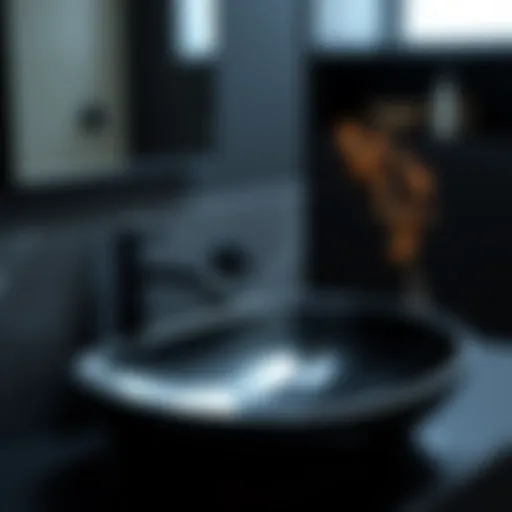Bar Stools vs Counter Stools: Key Differences Explained


Intro
When it comes to enhancing interior spaces, the subtleties of bar and counter stools can often be overlooked yet they play a pivotal role in blending functionality with style. Understanding the differences between these two types of stools is more than just a matter of height; it encompasses a whole spectrum of design considerations and practical applications. From cozy kitchens to modern home bars, the right choice can elevate both the aesthetics and utility of a space.
In this guide, we aim to dive deep into the nuances that separate bar stools from counter stools, covering critical elements such as height variations, style preferences, comfort, and material choices. This information will equip homeowners, designers, and decor enthusiasts alike with the insights needed to navigate their furniture options effectively.
Design Trends
Current Trends in Furniture Styles
Design is always evolving, and bar and counter stools are no exception. Recent trends highlight an increasing desire for versatility and personal expression in furniture. Classic designs are getting a modern twist with a mix of materials; think sleek metal legs paired with plush velvet seats. Natural wood finishes remain popular, but they are often complemented by bold colors or unique patterns. Furthermore, sustainable materials are making their way into homes, appealing to eco-conscious consumers.
Another significant trend is the rise of multipurpose stools; many homeowners lean toward furniture that serves dual functions—like stools that double as storage solutions.
How to Incorporate Trends into Your Space
Incorporating current trends in your home doesn’t require a complete overhaul. Here are some effective ways to refresh your space with bar and counter stools:
- Pairing Styles: Mix and match stools with existing furniture. For instance, a modern metal stool can contrast nicely with rustic decor.
- Layering Textures: Use stools made from different materials in one area to create a layered look while maintaining coherence in color.
- Promoting Functionality: Choose stools that can easily be moved around, like those with wheels or lightweight frames; they work great for hosting guests.
When selecting stools, always keep the overall theme of the space in mind. A cohesive look is paramount to achieving an aesthetically pleasing environment without stepping on any design toes.
"A well-designed stool is not just a seat; it’s a statement piece that reflects your style and meets your needs."
Buying Guides
Choosing the Right Furniture for Different Rooms
Picking the right bar or counter stool isn’t simply about aesthetics. Depending on where you plan to use them, different criteria might apply. Here are some pointers for various settings:
- Kitchen: Consider comfort and ease of cleaning. Lightweight stools with fabric covers may not be ideal for busy kitchens.
- Home Bars: Height and flair are essential here. Choose taller stools that mimic the height of your bar; also, look for styles that complement your bar design.
- Outdoor Spaces: Durability matters. Materials that withstand weather elements while maintaining comfort should be prioritized.
Tips for Assessing Quality and Value
Investing in bar and counter stools can be significant, so it’s crucial to assess quality. Here are a few tips:
- Check Construction: Look for sturdy frames made from solid wood or metal, and pay attention to joints and welds.
- Feel the Finish: Wood should have a smooth finish, while upholstered stools should feel comfortable and well-padded.
- Read Reviews: Look for feedback from other consumers about durability and comfort to gauge true value.
In your quest for the perfect stool, these insights will guide you towards choices that balance both form and function.
Prelims to Stools
Stools, though often overlooked in the larger realm of furniture design, play a significant role in shaping the dynamics of both residential and commercial spaces. Generally, they offer an appealing blend of practicality and style that forms the backbone of many seating arrangements. Understanding stools, particularly bar and counter variations, can enable homeowners, designers, and anyone interested in decor to make well-informed decisions that enhance both functionality and aesthetics.
The first thing to acknowledge is the vast spectrum of stools available on the market. The distinction between the two primary types, bar stools and counter stools, is essential for anyone looking to optimize their space effectively. Both serve specific purposes but cater to different settings, heights, and interior styles.
Importance of Stools
When you think about stools, consider them as versatile and mobile seating solutions that do more than just provide a place to sit. They can transform the ambiance of a room and encourage social interactions, especially in kitchen islands or home bars. A well-chosen stool not only complements the surrounding décor but also enhances comfort and usability.
Benefits of Understanding Stools:
- Space Efficiency: Stools often occupy less space compared to traditional chairs, making them ideal for small apartments and limited dining areas.
- Flexibility: They can be easily rearranged or relocated according to the event or occasion, providing a functional seating arrangement for gatherings.
- Design Compatibility: With a plethora of styles available, from modern to rustic, choosing the right stool can unify disparate design elements within a room.
Key Considerations:
- Height: Knowing the right height is crucial. While bar stools commonly range from 28 to 32 inches in height, counter stools typically measure between 24 to 27 inches. Investing in the correct sizes helps ensure comfort and convenience.
- Material: The material influences both durability and style. Wooden stools may impart a warm feel, while metal or plastic options could lend a more contemporary edge.
- Ergonomics: A stool's design should prioritize comfort, particularly if it will be used for extended periods. Features like footrests and cushioned seats can make a notable difference.
- Aesthetic Appeal: The visual impact of stools is significant. They can serve as decorative elements in their own right, adding texture and interest to the space.
In essence, stools are not mere seating options; they embody functionality, style, and comfort. This article will delve deeper into the characteristics that distinguish bar stools from counter stools, and guide you through their respective uses, ultimately aiding you in selecting the perfect stools for your space.
Defining Bar Stools
Bar stools are quintessential pieces of furniture that have transcended from mere utility to pivotal design elements in contemporary spaces. Understanding bar stools brings to light their significance not only in function but also in enhancing the overall aesthetic of a room. Their height, style, and purpose can deeply influence how a space feels and functions, making it essential for homeowners and designers to grasp their characteristics.
Height Specifications
Typically, bar stools are designed to fit counters and bars that are 40 to 42 inches high. This standard height allows for optimal comfort and usability. Most bar stools stand between 28 to 32 inches from the ground to the seat. When selecting a bar stool, one should maintain a distance of about 10 to 12 inches from the seat of the stool to the underside of the countertop. This ensures ample room for legs and contributes to a comfortable sitting experience.


It's worth noting that not all bar stools are created equal. Some come with adjustable heights, allowing them to adapt to various settings and preferences. This flexibility is particularly beneficial in multifunctional spaces where the same stool might be used at different surfaces.
Typical Uses and Settings
Bar stools find their place in a variety of settings, ranging from residential spaces to bustling commercial environments. In homes, they are often used at kitchen islands, breakfast bars, or home bars, fostering an inviting atmosphere for social interaction. For example, you might picture a cozy Sunday morning where family members gather, cups of coffee in hand, seated at a tall island breakfast bar.
In commercial venues, such as cafes or pubs, bar stools are strategically placed to encourage quick service and casual dining experiences. They tend to be favorites for social hours or happy hour, where seating flexibility is a key consideration. Overall, the versatility of bar stools makes them suitable for a wide array of environments, underscoring their integral role in modern design.
Design Trends in Bar Stools
Recent design trends in bar stools exhibit a rich tapestry of styles that cater to various tastes and interior designs. From minimalist designs with sleek lines to rustic wooden stools that bring warmth, the options are plentiful. A few noteworthy trends include:
- Industrial Style: Bar stools made out of metal and reclaimed wood fit well in urban-themed spaces, exuding a raw and edgy aesthetic.
- Color Pops: Brightly colored stools can add a splash of personality to muted environments, serving as focal points without overwhelming the design.
- Comfort-Centric Designs: Ergonomically designed bar stools featuring cushioned seats and backrests have gained popularity, marrying aesthetics with comfort.
As styles continue to evolve, the importance of choosing bar stools that resonate with both personal taste and the intended use cannot be overstated. This conscious selection can enhance not only the physical space but also the mood and function of gatherings.
Understanding Counter Stools
Counter stools serve a unique purpose in both homes and commercial settings. Typically, these stools bridge the gap between comfort and practicality, providing a seated option that aligns well with counters, kitchen islands, and breakfast bars. Understanding counter stools is crucial for anyone looking to enhance their space with functional furniture while ensuring visual appeal. Their height, style, and comfort level can transform a merely functional area into a cozy nook for socializing, dining, or casual work.
Height Differences
When it comes to counter stools, height is a defining aspect. Counter stools generally stand between 24 to 26 inches, which makes them compatible with counters that are about 36 inches high. This specific sizing allows for a comfortable seating arrangement, promoting ease during interactions whether you're sipping coffee or having a meal.
Comparatively, bar stools tend to be taller, usually around 28 to 32 inches, catered to bars or higher tables. If you mismatch the heights, it can lead to an awkward dining experience—imagine a stool that's too short for the counter, leaving you feeling like you're perched on a child’s chair. Conversely, using a bar stool at a counter can make it difficult to sit comfortably.
This height distinction not only affects comfort but also impacts the overall design flow of your space. Getting the heights right ensures that the aesthetics match the functionality, creating a seamless integration with your countertops.
Common Applications
Counter stools find themselves in various scenarios. They fit perfectly in residential kitchens, where families gather for breakfast or after-school snacks. Many homeowners also use them in home offices, allowing a casual yet functional workspace. Here's a quick overview of where counter stools typically shine:
- Kitchens: Ideal for islands or breakfast bars, enhancing social interaction during meal prep.
- Home Bars: Offering an inviting seating option for entertaining guests during gatherings.
- Restaurants and Cafés: Frequently seen where counter service is prevalent, providing patrons a comfortable place to dine.
- Compact Spaces: Suitable for small apartments or dens, where a little extra seating can make a big difference.
When strategically placed, counter stools can encourage more interaction in a space. Adding a few to your kitchen can create an inviting atmosphere, making it more conducive to family bonding or entertaining friends.
Popular Designs and Styles
In the world of counter stools, variety is the name of the game. From rustic wooden designs to sleek metal frames, there are numerous styles to cater to differing tastes and home aesthetics. Here are some popular designs:
- Traditional: Often crafted from sturdy wood, these stools emphasize classic designs and timeless appeal. They provide a warm and inviting atmosphere.
- Modern: Generally, these stools have clean lines and a minimalist approach. Materials such as metal or molded plastic dominate this category.
- Industrial: Sometimes featuring a distressed finish or exposed hardware, these stools combine function with an edgy design, perfect for urban-style spaces.
- Upholstered: Offering extra comfort, these stools are usually padded and covered in various fabrics or leathers, making them suitable for longer sitting periods.
Choosing a style that complements your home decor can enhance both the functionality and aesthetics of your space. Consider where the stools will be used and how they can blend with existing furniture.
"Choosing the right stool isn't just about height; it's about harmonizing style and function to elevate your living space."
In summary, understanding counter stools encompasses recognizing their height, applications, and design choices. With this knowledge, homeowners, designers, and enthusiasts can make informed decisions that have a lasting impact on their interiors.
Comparison: Bar Stools vs. Counter Stools
When it comes to furnishing kitchens, dining areas, or social spaces, understanding the differences between bar stools and counter stools is crucial. This topic touches on fundamental elements that can vastly affect both functionality and style within various environments. Selecting between these two types of seating isn’t simply a choice about height or design; it involves considerations regarding comfort, suitability for specific spaces, and how the overall aesthetic ties into your home's decor.
Being aware of these distinctions allows homeowners, designers, and DIY enthusiasts to make informed decisions. Let’s delve into some critical aspects that will help clarify the nuances between bar stools and counter stools.
Height and Comfort Considerations
At the heart of the conversation about bar stools and counter stools lies their height. Bar stools typically range from 28 to 32 inches in seat height, designed to pair perfectly with counter heights of 40 to 42 inches. On the other hand, counter stools, which range from 24 to 27 inches, are made for kitchen islands and counters standing between 35 and 39 inches tall.
This height difference isn’t just a number; it has real implications for comfort. A bar stool can elevate you above the counter, providing a vantage point for social interaction or a sumptuous view, while counter stools accommodate a closer seating arrangement that invites conversation.
When choosing stools, consider not just the height but also how they feel to sit on. The right stool should make you feel at ease, whether you’re enjoying breakfast or entertaining friends. For instance, some might prefer the gentle curve and plush cushioning of a well-designed bar stool, while others might choose a minimalist counter stool that allows for a more casual and relaxed vibe.
Material Perspectives
Materials play a significant role in the overall appeal and usability of bar and counter stools. Common materials include wood, metal, and plastic, each bringing distinct characteristics.
- Wood: Offers warmth and can be both rustic and elegant. A wooden bar stool might evoke a cozy tavern feel, while a sleek wood counter stool can lend sophistication to a modern kitchen.
- Metal: Often favored for its durability and industrial vibe. Metal stools can withstand the rigors of frequent use, particularly in bustling environments like bars or restaurants. They can also provide a striking contrast when combined with softer materials.
- Plastic: Lightweight and often available in a rainbow of colors, plastic stools can be perfect for casual settings or where ease of movement is essential.


With the breadth of choices, it’s important to match the stool material to the intended use and the overall aesthetic of the space.
Aesthetic Comparisons
Design is where personal taste shines brightest. Bar stools and counter stools come in a myriad of styles—from classic and contemporary to sleek and playful. Understanding how each style can fit into your home is vital when selecting the right piece.
- Bar Stools: Often available in taller, sleeker forms, they become a focal point at an island or bar. The added height can capture attention, making it a subtle statement piece.
- Counter Stools: Typically broader and sturdier, counter stools can have a homier appearance. The variety of designs, including backs, armrests, or no-frills options, makes them adaptable to almost any décor.
One might consider a vintage leather bar stool juxtaposed against a modern kitchen's stainless-steel appliances, which can create a fascinating dialogue in design. Similarly, the selection of colors, fabrics, and finishes can either enhance or diminish the overall ambiance, requiring careful consideration.
In summary, comprehending the differences between bar stools and counter stools is vital for making the right choice in design and usability. Factors like height, material, and style each play pivotal roles in how these pieces interact with your space, reinforcing that attentive selection can significantly enhance the comfort and aesthetic appeal of your environment.
Factors Influencing Choice
Choosing the right stool for your space involves several key factors, each influencing the final decision. Understanding these elements can guide homeowners, designers, and DIYers in selecting pieces that not only match their interior aesthetic but also serve the specific functional needs of the space. Here’s a closer look at what influences the choice of bar and counter stools and why each consideration is vital.
Height of the Counter/Bar
When it comes to stools, height matters significantly. Stools must match the height of either the bar or counter they are intended for.
- Bar stools are generally taller, typically ranging from 28 to 32 inches in height. These stools are perfect for standard bar heights, which usually stand at around 40 to 42 inches.
- Counter stools, on the other hand, are shorter, usually between 24 to 27 inches, designed for counters that are about 36 inches in height.
Measuring the height of your counter or bar accurately is crucial. A stool too high can make it uncomfortable and awkward to sit down or get up. Conversely, a stool that is too low can lead to poor posture and discomfort. Hence, having the proper height ensures usability and comfort which is essential for daily use.
Stool Style and Room Aesthetics
The style of the stool you choose will greatly influence the overall look and feel of your space. Different styles can evoke various atmospheres. For example:
- Modern stools often feature sleek lines and minimalist designs, making them ideal for contemporary spaces.
- Rustic stools made of reclaimed wood add warmth and character, suitable for farmhouse or vintage-inspired settings.
Depending on the aesthetic you wish to achieve, you should consider how the materials and colors of the stools reflect or contrast the existing décor. Selecting a stool that harmonizes with your environment can enhance visual appeal significantly. A well-chosen stool can become a focal point, elevating the entire room's design without overwhelming it.
Comfort and Usability
Finally, comfort cannot be overlooked. A stool that looks great but is uncomfortable can ruin the experience of using it, whether for dining or socializing. The following aspects should be taken into account:
- Seat Material: Cushioned stools with upholstery can provide greater comfort than hard seats. Materials such as leather, velvet, or even high-durability fabrics can add a layer of coziness and style.
- Footrests: Consider whether the stool has a footrest, which can enhance relaxation while seated.
- Backrest: High-back stools offer more support and are often preferred for long periods of sitting.
Thus, ensuring that the stools you invest in provide excellent comfort and usability is essential for functional living spaces. Your choice should reflect not just aesthetic considerations but the everyday practicalities of life.
Key Insight: Comfort isn’t just a luxury; it's a necessity for spaces where people gather and converse. Don't underestimate the impact of a well-designed stool on your enjoyment of a space.
Ergonomic Aspects of Stools
Understanding the ergonomic aspects of stools is vital, particularly as more people seek comfort and support in their living spaces. Stools, whether they are bar or counter style, can immensely impact our daily interactions. The right stool not only elevates spaces visually but plays a pivotal role in enhancing our comfort during prolonged use. It is not just about aesthetics; the key to a productive sitting experience is rooted in how well a stool supports our bodies.
Designing for Comfort
When talking about stool design, comfort is paramount. The cushion density, seat shape, and materials all contribute to how a stool feels over time. A well-designed stool should cradle the body without putting pressure on any single point. Think about stools made from memory foam or those that have generous padding. These materials adapt to the user's shape, easing discomfort during long periods of sitting.
Moreover, the depth and width of a stool's seat can dictate comfort. Wider seats allow for more movement but can make it harder to sit properly. Conversely, narrower seats may promote better posture but can feel restrictive over time. Ideally, it's about finding that sweet spot where the user feels supported without being confined.
Let’s break down some important elements:
- Cushioning: Quality cushioning can make all the difference. When selecting a stool, consider how thick the padding is and what it’s made of.
- Seat Contours: Seats that are slightly curved are often more comfortable than flat ones, helping to meet the natural shape of the body.
- Adjustability: Some stools offer adjustable heights. This feature is particularly beneficial for varying user heights and preferences.
Supporting Good Posture
Good posture while seated can be a game-changer for health and comfort. With the right stool, users can reduce strain on their back and neck, leading to improved overall well-being. Stools that promote an optimal seated posture encourage the user to sit up straight, keeping the spine aligned.
A few considerations for supporting posture include:
- Footrests: Stools equipped with footrests help distribute weight evenly and reduce pressure on the legs. This can encourage circulation and comfort over time.
- Back Support: Some stools come with a backrest, while others do not. It’s essential to consider the role of lumbar support, which can provide the needed support for the lower back when sitting.
- Seat Height: The stool's height should allow the user's feet to rest flat on the ground or on a footrest, which is key for maintaining proper spinal alignment.
"An ergonomic stool is often the unsung hero in home and commercial spaces, marrying functionality with comfort."
Ultimately, the right stool can make a significant difference in daily routines, whether for casual gatherings, a morning coffee, or lengthy working hours. By focusing on ergonomics, homeowners, designers, and enthusiasts can better appreciate how to enhance comfort, style, and utility in their spaces.


Care and Maintenance of Stools
The care and maintenance of stools goes beyond mere upkeep; it directly impacts their longevity and aesthetic appeal. Whether you own bar stools or counter stools, regular attention ensures these essential pieces remain in top shape, serving both function and flair in your space. It's important to note that the material of your stools plays a significant role in determining the methods of care. Understanding this can save you time and money in the long run. The right maintenance can help prevent wear, keep them looking fresh, and maintain their comfort.
Cleaning Techniques by Material
Different stool materials require distinct cleaning approaches. Understanding these can help you preserve the look and feel of your furniture.
- Wooden Stools: A bit of care goes a long way. Use a damp cloth along with a mild soap solution to wipe them down. Afterward, dry immediately to prevent moisture damage. For deep cleaning, consider applying a wood conditioner every six months.
- Metal Stools: These are generally durable but can rust. So, clean with a soft cloth and a mixture of vinegar and water. This is great for reducing oxidation. For painted finishes, ensure to avoid abrasive cleaners that might scratch the surface.
- Plastic Stools: The bad news is they can fade over time. Regular cleaning with warm soapy water is ideal. If you notice stains, a gentle scrub with a soft brush can help restore its shine.
- Upholstered Stools: The fabric often varies, so check for the manufacturer’s recommendations first. Generally, a vacuum can help get rid of dust and crumbs. For deeper cleaning, a fabric cleaner suitable for the specific type of upholstery is necessary. Always test on a hidden area first to avoid damage.
Each of these methods not only keeps your stools functional but also enhances their visual appeal in your home.
“A little maintenance goes a long way. The right care can turn years of use into decades.”
Long-Term Maintenance Strategies
To ensure your stools stand the test of time, it’s necessary to adopt long-term maintenance strategies. Here are some essential steps to consider:
- Placement Matters: Avoid putting stools in direct sunlight, as this can lead to fading and cracking, especially with wood and fabric.
- Regular Checks: Inspect joints and bolts if they are adjustable. Tightening them periodically can avoid wobbly stools.
- Use Cushions: For upholstered or wooden stools, adding cushions can not only enhance comfort but also protect against wear and tear.
- Seasonal Cleaning: Once a season, dedicate time for a thorough clean beyond the regular wipe-down. This could include tightening screws, polishing wood, or checking for spills on upholstery.
- Appropriate Storage: If you have folding stools or seasonal stools, store them in a cool, dry place away from moisture. This helps prevent warping or deterioration of materials over time.
Maintaining stools requires a blend of knowledge and effort. By adopting these cleaning techniques and long-term strategies, you can ensure that your stools not only serve you well but also contribute positively to your decor. A well-cared-for stool isn’t just furniture; it’s a statement piece that enhances your living space.
Cost Considerations
When picking out bar and counter stools for your home, one of the significant elements to keep in mind is the cost. This factor shouldn't be regarded as merely a number on a tag; it genuinely relates to quality, durability, and how well the items will meet your needs over time. The importance of understanding cost considerations lies in equipping you with the knowledge to differentiate between what is worthwhile to invest in compared to what could be just a poor spend.
A well-researched approach to cost can lead to long-term satisfaction with your purchases. Spending a little more upfront for quality, for example, can save you hassle and worry later on since cheaper items might not hold up to daily use or could require replacement more frequently. Yet, it is important to balance quality with affordability. Here’s where your budgeting plays a critical role.
Budgeting for Quality
Creating a budget helps you not only decide how much you are willing to spend but also assists in prioritizing the characteristics that are non-negotiable for you. Quality bar and counter stools can range in price based on materials, design, and brand reputation. Factors such as craftsmanship, sturdiness, and the comfort they provide should weigh significantly into your budget.
- Materials: Solid wood and high-grade metal often demand a higher price but can last much longer.
- Design: Unique or designer styles may add to the cost, but innovative designs can enhance your space's overall aesthetic and functionality.
- Brand Reputation: Some brands are known for their durability and service, hence their price tags reflect that reputation.
You might find it helpful to list out key features that matter most to you. For example:
- Comfort: Cushioned seats or ergonomic designs.
- Style: Whether it complements existing decor.
- Durability: Resistance to wear and tear, especially in high-traffic areas.
Evaluating Cost vs. Longevity
Once you have set a budget, the next step is to evaluate the potential longevity of the stools you are considering. It's not uncommon to stumble upon a great deal on stools that seem perfect at first glance; however, the questions you should ask include:
- How well are they constructed? Pay attention to the joints and materials used; a well-built stool will often outlast a cheaper counterpart.
- What kind of warranty is offered? When a manufacturer believes in their product, they often back it up with a warranty that indicates a level of trust and quality.
- Will they require a lot of maintenance? Some materials may need regular upkeep that can add to overall cost over time.
"Investing in high-quality items may be more expensive initially, but they can be a worthwhile expenditure in the long run."
It's crucial to analyze how frequently you plan on using these stools and how they fit into your lifestyle. For example, if you have children or foresee extensive entertaining, opting for something robust might be the wiser choice, even if it stretches the budget a bit. Choosing wisely by weighing cost against longevity can mean the difference between a smart purchase and a regrettable one.
The End: Making an Informed Decision
Navigating the world of bar and counter stools isn't just an exercise in aesthetics; it's about functionality and how these pieces fit into your everyday life. Knowing which kind of stool suits your space is crucial, impacting everything from your daily comfort to your overall interior design. This guide aims to distill those considerations, helping you discern what works best for your unique needs.
When making your choice, consider height, material, and what kind of vibe you want to create in the space. Just as important as style is how the stools will be used. Will they serve as extra seating for guests, or do you need them mainly for a home bar? Addressing these questions will lead you to make a well-rounded decision.
"The right bar or counter stool can enhance the ambiance of a room and promote comfort and usability."
While trends are always changing, your personal comfort and stylistic preferences should guide you. Therefore, it's essential to weigh each element discussed in this article carefully. Remember that even small choices can make a big difference.
Final Thoughts on Selection
Understanding the differences between bar stools and counter stools can empower you to make a more confident decision. Visualize where these stools will go in your home. Are they near a kitchen island? If so, perhaps a counter stool is the way to go. However, if your home has a dedicated bar area, bar stools may be the better fit.
Ultimately, timeless styles often outlast fleeting trends. Classic designs, neutral colors, and durable materials can offer longevity to your investment. Whichever route you choose, ensure that the stool not only enhances the look of your space but also serves its purpose effectively.
Encouraging Personal Evaluation of Needs
Before rushing into a purchase, take some time to assess your specific needs. Walk through your home, consider:
- The height of your countertop or bar
- The overall layout and flow of your room
- How often you entertain or use that space
Creating a checklist of these factors can be incredibly beneficial. Ask yourself how many stools you need and if they should have backs or armrests depending on comfort and practicality. Maybe you have kids or pets to consider, which might influence the materials you choose.
It's also a good idea to test out different stool types in person if possible. Sit down, wiggle around a bit, and see what feels right. Remember, you're not just buying furniture; you're buying into an experience that will affect how you and your guests enjoy that space.















